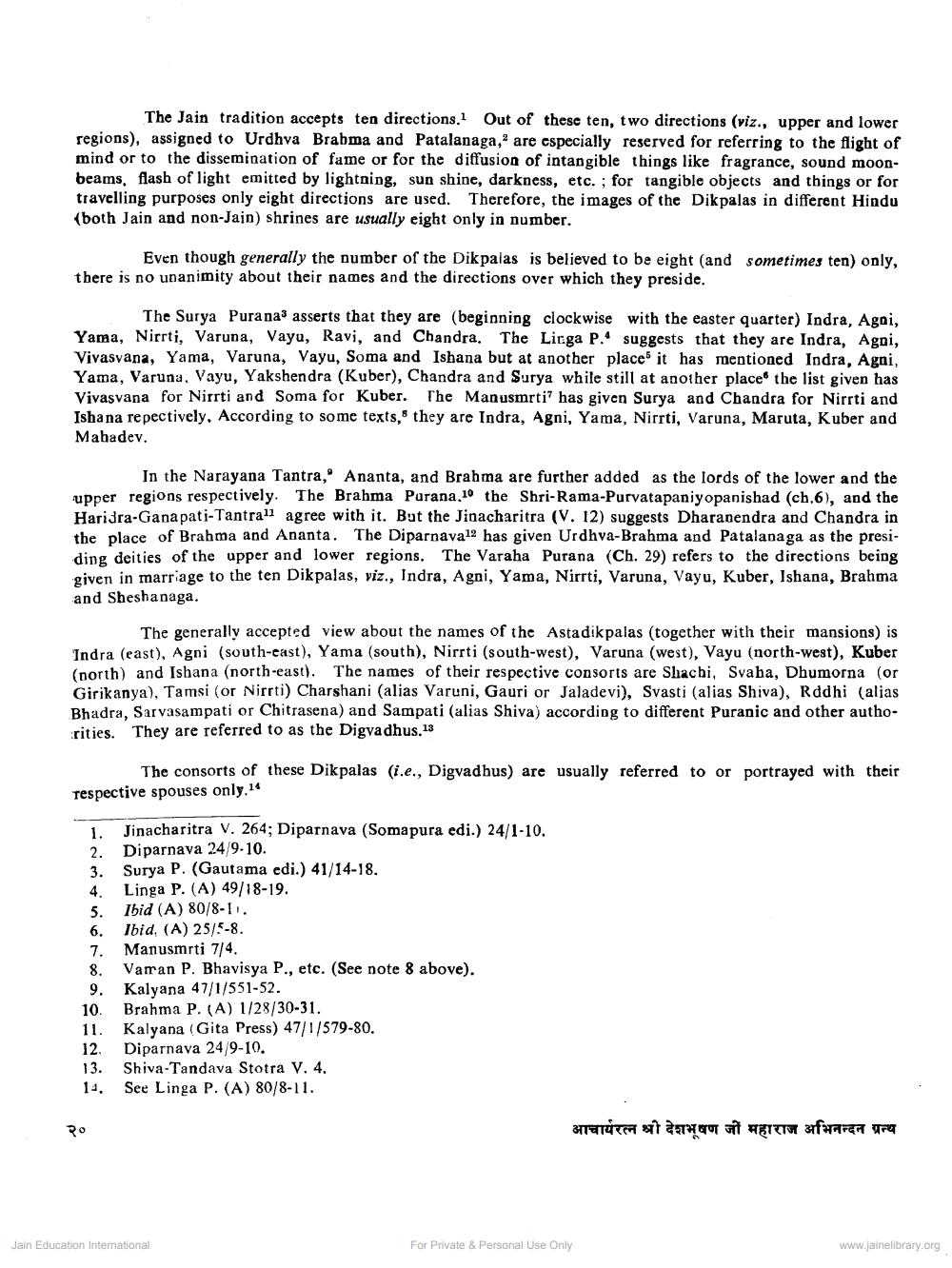________________
The Jain tradition accepts ten directions. Out of these ten, two directions (viz., upper and lower regions), assigned to Urdhva Brabma and Patalanaga,' are especially reserved for referring to the flight of mind or to the dissemination of fame or for the diffusion of intangible things like fragrance, sound moonbeams, flash of light emitted by lightning, sun shine, darkness, etc.; for tangible objects and things or for travelling purposes only eight directions are used. Therefore, the images of the Dikpalas in different Hindu (both Jain and non-Jain) shrines are usually eight only in number.
Even though generally the number of the Dikpalas is believed to be eight (and sometimes ten) only, there is no unanimity about their names and the directions over which they preside.
The Surya Purana: asserts that they are (beginning clockwise with the easter quarter) Indra, Agai, Yama. Nirrti. Varuna, Vayu, Ravi, and Chandra. The Lirga P. suggests that they are Indra, Agoi, Vivasvana, Yama, Varuna, Vayu, Soma and Ishana but at another place it has mentioned Indra, Agni, Yama, Varuna, Vayu, Yakshendra (Kuber), Chandra and Surya while still at another place the list given has Vivasvana for Nirrti and Soma for Kuber. The Manusmrtihas given Surya and Chandra for Nirrti and Isha na repectively. According to some texts, they are Indra, Agni, Yama, Nirrti, Varuna, Maruta, Kuber and Mahadev.
In the Narayana Tantra, Ananta, and Brahma are further added as the lords of the lower and the upper regions respectively. The Brahma Purana.10 the Shri-Rama-Purvatapaniyopanishad (ch.6), and the Hariðra-Ganapati-Tantrall agree with it. But the Jinacharitra (V. 12) suggests Dharanendra and Chandra in the place of Brahma and Ananta. The Diparnaval2 has given Urdhva-Brahma and Patalanaga as the presiding deities of the upper and lower regions. The Varaha Purana (Ch. 29) refers to the directions being given in marriage to the ten Dikpalas, viz., Indra, Agni, Yama, Nirrti, Varuna, Vayu, Kuber, Ishana, Brahma and Sheshanaga.
The generally accepted view about the names of the Astadikpalas (together with their mansions) is Indra (east), Agni (south-east), Yama (south), Nirrti (south-west), Varuna (west), Vayu (north-west), Kuber (north) and Ishana (north-east). The names of their respective consorts are Shachi. Svaha, Dhumorna (or Girikanya), Tamsi (or Nirrti) Charshani (alias Varuni, Gauri or Jaladevi), Svasti (alias Shiva), Rddhi (alias Bhadra, Sarvasampati or Chitrasena) and Sampati (alias Shiva) according to different Puranic and other authorities. They are referred to as the Digvadhus. 13
The consorts of these Dikpalas (i.e., Digvadhus) are usually referred to or portrayed with their respective spouses only. 14
1. Jinacharitra V. 264; Diparnava (Somapura edi.) 24/1-10. 2. Diparnava 24 9.10. 3. Surya P. (Gautama edi.) 41/14-18. 4. Linga P. (A) 49/18-19.
Ibid (A) 80/8-11. 6. Ibid. (A) 25/5-8. 7. Manusmrti 7/4. 8. Varan P. Bhavisya P., etc. (See note 8 above). 9. Kalyana 47/1/551-52. 10. Brahma P. (A) 1/28/30-31. 11. Kalyana (Gita Press) 47/1/579-80. 12. Diparnava 24/9-10.
Shiva-Tandava Stotra V. 4. 14. See Linga P. (A) 80/8-11.
13.
आचार्यरत्न श्री देशभूषण जी महाराज अभिनन्दन ग्रन्थ
Jain Education International
For Private & Personal Use Only
www.jainelibrary.org




